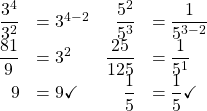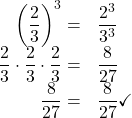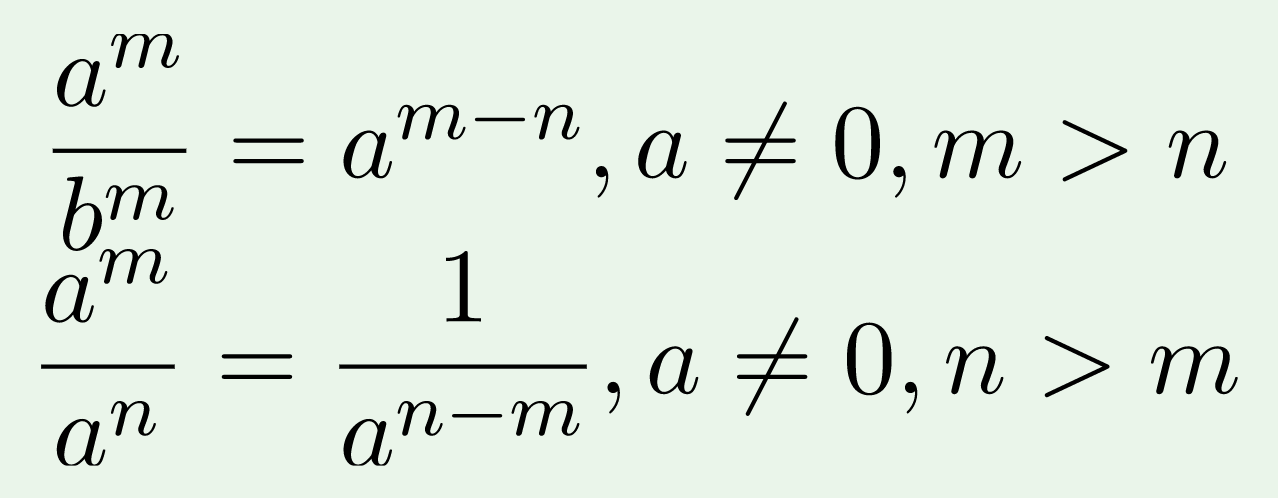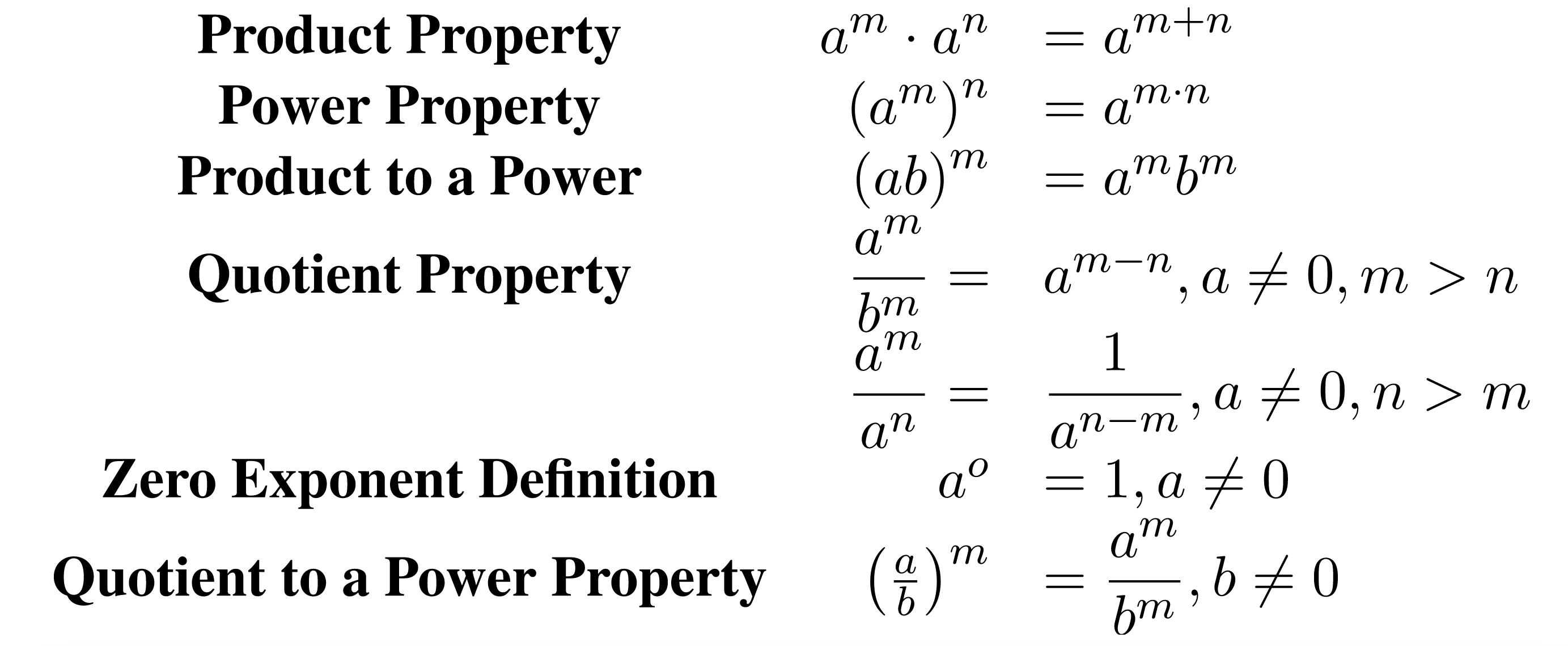CHAPTER 7 Powers, Roots, and Scientific Notation
7.2 Use Quotient Property of Exponents
Learning Objectives
By the end of this section, you will be able to:
- Simplify expressions using the Quotient Property for Exponents
- Simplify expressions with zero exponents
- Simplify expressions using the quotient to a Power Property
- Simplify expressions by applying several properties
Simplify Expressions Using the Quotient Property for Exponents
Earlier in this chapter, we developed the properties of exponents for multiplication. We summarize these properties below.
Summary of Exponent Properties for Multiplication
If ![]() and
and ![]() are real numbers, and
are real numbers, and ![]() and
and ![]() are whole numbers, then
are whole numbers, then
| Product Property | |
| Power Property | |
| Product to a Power |
Now we will look at the exponent properties for division. A quick memory refresher may help before we get started. You have learned to simplify fractions by dividing out common factors from the numerator and denominator using the Equivalent Fractions Property. This property will also help you work with algebraic fractions—which are also quotients.
Equivalent Fractions Property
If ![]() , and
, and ![]() are whole numbers where
are whole numbers where ![]() ,
,
As before, we’ll try to discover a property by looking at some examples.
| Consider | and | ||
| What do they mean? | |||
| Use the Equivalent Fractions Property. | |||
| Simplify. |
Notice, in each case the bases were the same and we subtracted exponents.
When the larger exponent was in the numerator, we were left with factors in the numerator.
When the larger exponent was in the denominator, we were left with factors in the denominator—notice the numerator of 1
We write:

This leads to the Quotient Property for Exponents.
Quotient Property for Exponents
If ![]() is a real number,
is a real number, ![]() , and
, and ![]() and
and ![]() are whole numbers, then
are whole numbers, then
A couple of examples with numbers may help to verify this property.

EXAMPLE 1
Simplify: a) ![]() b)
b) ![]() .
.
To simplify an expression with a quotient, we need to first compare the exponents in the numerator and denominator.
-
Since 9 > 7, there are more factors of x in the numerator. 
Use the Quotient Property,  .
.
Simplify. 
-
Since 10 > 2, there are more factors of x in the numerator. 
Use the Quotient Property,  .
.
Simplify. 
Notice that when the larger exponent is in the numerator, we are left with factors in the numerator.
TRY IT 1.1
Simplify: a) ![]() b)
b) ![]() .
.
Show answer
a) ![]() b)
b) ![]()
TRY IT 1.2
Simplify: a) ![]() b)
b) ![]() .
.
Show answer
a) ![]() b)
b) ![]()
EXAMPLE 2
Simplify: a) ![]() b)
b) ![]() .
.
To simplify an expression with a quotient, we need to first compare the exponents in the numerator and denominator.
-
Since 12 > 8, there are more factors of b in the denominator. 
Use the Quotient Property,  .
.
Simplify. 
-
Since 5 > 3, there are more factors of 3 in the denominator. 
Use the Quotient Property,  .
.
Simplify. 
Simplify. 
Notice that when the larger exponent is in the denominator, we are left with factors in the denominator.
TRY IT 2.1
Simplify: a) ![]() b)
b) ![]() .
.
Show answer
a) ![]() b)
b) ![]()
TRY IT 2.2
Simplify: a) ![]() b)
b) ![]() .
.
Show answer
a) ![]() b)
b) ![]()
Notice the difference in the two previous examples:
- If we start with more factors in the numerator, we will end up with factors in the numerator.
- If we start with more factors in the denominator, we will end up with factors in the denominator.
The first step in simplifying an expression using the Quotient Property for Exponents is to determine whether the exponent is larger in the numerator or the denominator.
EXAMPLE 3
Simplify: a) ![]() b)
b) ![]() .
.
- Is the exponent of
 larger in the numerator or denominator? Since 9 > 5, there are more
larger in the numerator or denominator? Since 9 > 5, there are more  in the denominator and so we will end up with factors in the denominator.
in the denominator and so we will end up with factors in the denominator.

Use the Quotient Property,  .
.
Simplify. 
- Notice there are more factors of
 in the numerator, since 11 > 7. So we will end up with factors in the numerator.
in the numerator, since 11 > 7. So we will end up with factors in the numerator.

Use the Quotient Property,  .
.
Simplify. 
TRY IT 3.1
Simplify: a) ![]() b)
b) ![]() .
.
Show answer
a) ![]() b)
b) ![]()
TRY IT 3.2
Simplify: a) ![]() b)
b) ![]() .
.
Show answer
a) ![]() b)
b) ![]()
Simplify Expressions with an Exponent of Zero
A special case of the Quotient Property is when the exponents of the numerator and denominator are equal, such as an expression like ![]() . From your earlier work with fractions, you know that:
. From your earlier work with fractions, you know that:
![]()
In words, a number divided by itself is 1. So, ![]() , for any
, for any ![]() , since any number divided by itself is 1
, since any number divided by itself is 1
The Quotient Property for Exponents shows us how to simplify ![]() when
when ![]() >
> ![]() and when
and when ![]() <
< ![]() by subtracting exponents. What if
by subtracting exponents. What if ![]() ?
?
Consider ![]() , which we know is 1
, which we know is 1
| Write |
|
| Subtract exponents. | |
| Simplify. |
Now we will simplify ![]() in two ways to lead us to the definition of the zero exponent. In general, for
in two ways to lead us to the definition of the zero exponent. In general, for ![]() :
:

We see ![]() simplifies to
simplifies to ![]() and to 1. So
and to 1. So ![]() .
.
Zero Exponent
If ![]() is a non-zero number, then
is a non-zero number, then ![]() .
.
Any nonzero number raised to the zero power is 1
In this text, we assume any variable that we raise to the zero power is not zero.
EXAMPLE 4
Simplify: a) ![]() b)
b) ![]() .
.
The definition says any non-zero number raised to the zero power is 1
| a) Use the definition of the zero exponent. |
|
| b) Use the definition of the zero exponent. |
TRY IT 4.1
Simplify: a) ![]() b)
b) ![]() .
.
Show answer
a) 1 b) 1
TRY IT 4.2
Simplify: a) ![]() b)
b) ![]() .
.
Show answer
a) 1 b) 1
Now that we have defined the zero exponent, we can expand all the Properties of Exponents to include whole number exponents.
What about raising an expression to the zero power? Let’s look at ![]() . We can use the product to a power rule to rewrite this expression.
. We can use the product to a power rule to rewrite this expression.
| Use the product to a power rule. | |
| Use the zero exponent property. | |
| Simplify. |
This tells us that any nonzero expression raised to the zero power is one.
EXAMPLE 5
Simplify: a) ![]() b)
b) ![]() .
.
| a) | |
| Use the definition of the zero exponent. | |
| b) | |
| Use the definition of the zero exponent. |
TRY IT 5.1
Simplify: a) ![]() b)
b) ![]() .
.
Show answer
a) ![]() b)
b) ![]()
TRY IT 5.2
Simplify: a) ![]() b)
b) ![]() .
.
Show answer
a) ![]() b)
b) ![]()
Simplify Expressions Using the Quotient to a Power Property
Now we will look at an example that will lead us to the Quotient to a Power Property.
| This means: | |
| Multiply the fractions. | |
| Write with exponents. |
Notice that the exponent applies to both the numerator and the denominator.
| We write: | |
This leads to the Quotient to a Power Property for Exponents.
Quotient to a Power Property for Exponents
If ![]() and
and ![]() are real numbers,
are real numbers, ![]() , and
, and ![]() is a counting number, then
is a counting number, then
To raise a fraction to a power, raise the numerator and denominator to that power.
An example with numbers may help you understand this property:

EXAMPLE 6
Simplify: a) ![]() b)
b) ![]() c)
c) ![]() .
.
a)
 |
|
| Use the Quotient Property, |
 |
| Simplify. |  |
b)
 |
|
| Use the Quotient Property, |
 |
| Simplify. |  |
c)
 |
|
| Raise the numerator and denominator to the third power. |  |
TRY IT 6.1
Simplify: a) ![]() b)
b) ![]() c)
c) ![]() .
.
Show answer
a) ![]() b)
b) ![]() c)
c) ![]()
TRY IT 6.2
Simplify: a) ![]() b)
b) ![]() c)
c) ![]() .
.
Show answer
a) ![]() b)
b) ![]() c)
c) ![]()
Simplify Expressions by Applying Several Properties
We’ll now summarize all the properties of exponents so they are all together to refer to as we simplify expressions using several properties. Notice that they are now defined for whole number exponents.
Summary of Exponent Properties
If ![]() and
and ![]() are real numbers, and
are real numbers, and ![]() and
and ![]() are whole numbers, then
are whole numbers, then
| Product Property | |
| Power Property | |
| Product to a Power | |
| Quotient Property |  |
| Zero Exponent Definition | |
| Quotient to a Power Property |
EXAMPLE 7
Simplify: ![]() .
.
| Multiply the exponents in the numerator. | |
| Subtract the exponents. |
TRY IT 7.1
Simplify: ![]() .
.
Show answer
![]()
TRY IT 7.2
Simplify: ![]() .
.
Show answer
![]()
EXAMPLE 8
Simplify: ![]() .
.
| Multiply the exponents in the numerator. | |
| Subtract the exponents. | |
| Simplify. |
TRY IT 8.1
Simplify: ![]() .
.
Show answer
1
TRY IT 8.2
Simplify: ![]() .
.
Show answer
1
EXAMPLE 9
Simplify: ![]() .
.
| Remember parentheses come before exponents. Notice the bases are the same, so we can simplify inside the parentheses. Subtract the exponents. |
|
| Multiply the exponents. |
TRY IT 9.1
Simplify: ![]() .
.
Show answer
![]()
TRY IT 9.2
Simplify: ![]() .
.
Show answer
![]()
EXAMPLE 10
Simplify: ![]() .
.
Here we cannot simplify inside the parentheses first, since the bases are not the same.
| Raise the numberator and denominator to the third power using the Quotient to a Power Property, |
|
| Use the Power Property and simplify. |
TRY IT 10.1
Simplify: ![]() .
.
Show answer
![]()
TRY IT 10.2
Simplify: ![]() .
.
Show answer
![]()
EXAMPLE 11
Simplify: ![]() .
.
| Raise the numberator and denominator to the fourth power, using the Quotient to a Power Property, |
 |
| Raise each factor to the fourth power. |  |
| Use the Power Property and simplify. |
TRY IT 11.1
Simplify: ![]() .
.
Show answer
![]()
TRY IT 11.2
Simplify: ![]() .
.
Show answer
![]()
EXAMPLE 12
Simplify:  .
.
 |
|
| Use the Power Property, |
|
| Add the exponents in the numerator. | |
| Use the Quotient Property, |
TRY IT 12.1
Simplify:  .
.
Show answer
![]()
TRY IT 12.2
Simplify:  .
.
Show answer
![]()
EXAMPLE 13
Simplify:  .
.
 |
|
| Use the Product to a Power Property, |
 |
| Use the Power Property, |
|
| Add the exponents in the denominator. | |
| Use the Quotient Property, |
|
| Simplify. |
TRY IT 13.1
Simplify:  .
.
Show answer
![]()
TRY IT 13.2
Simplify:  .
.
Show answer
![]()
Divide Monomials
You have now been introduced to all the properties of exponents and used them to simplify expressions. Next, you’ll see how to use these properties to divide monomials. Later, you’ll use them to divide polynomials.
EXAMPLE 14
Find the quotient: ![]() .
.
| Rewrite as a fraction. | |
| Use fraction multiplication. | |
| Simplify and use the Quotient Property. |
TRY IT 14.1
Find the quotient: ![]() .
.
Show answer
![]()
TRY IT 14.2
Find the quotient: ![]() .
.
Show answer
![]()
EXAMPLE 15
Find the quotient: ![]() .
.
Solution
| Use fraction multiplication. | |
| Simplify and use the Quotient Property. | |
| Multiply. |
TRY IT 15.1
Find the quotient: ![]() .
.
Show answer
![]()
TRY IT 15.2
Find the quotient: ![]() .
.
Show answer
![]()
EXAMPLE 16
Find the quotient: ![]() .
.
| Use fraction multiplication. | |
| Simplify and use the Quotient Property. | |
| Multiply. |
TRY IT 16.1
Find the quotient: ![]() .
.
Show answer
![]()
TRY IT 16.2
Find the quotient: ![]() .
.
Show answer
![]()
Once you become familiar with the process and have practiced it step by step several times, you may be able to simplify a fraction in one step.
EXAMPLE 17
Find the quotient: ![]() .
.
Be very careful to simplify ![]() by dividing out a common factor, and to simplify the variables by subtracting their exponents.
by dividing out a common factor, and to simplify the variables by subtracting their exponents.
| Simplify and use the Quotient Property. |
TRY IT 17.1
Find the quotient: ![]() .
.
Show answer
![]()
TRY IT 17.2
Find the quotient: ![]() .
.
Show answer
![]()
In all examples so far, there was no work to do in the numerator or denominator before simplifying the fraction. In the next example, we’ll first find the product of two monomials in the numerator before we simplify the fraction. This follows the order of operations. Remember, a fraction bar is a grouping symbol.
EXAMPLE 18
Find the quotient: ![]() .
.
| Simplify the numerator. | |
| Simplify. |
TRY IT 18.1
Find the quotient: ![]() .
.
Show answer
![]()
TRY IT 18.2
Find the quotient: ![]() .
.
Show answer
![]()
Additional Online Resources
Key Concepts
- Quotient Property for Exponents:
- If
 is a real number,
is a real number,  , and
, and  are whole numbers, then:
are whole numbers, then:
 >
>  >
> 
- If
- Zero Exponent
- If
 is a non-zero number, then
is a non-zero number, then  .
.
- If
- Quotient to a Power Property for Exponents:
- If
 and
and  are real numbers,
are real numbers,  , and
, and  is a counting number, then:
is a counting number, then:

- To raise a fraction to a power, raise the numerator and denominator to that power.
- If
- Summary of Exponent Properties
- If
 are real numbers and
are real numbers and  are whole numbers, then
are whole numbers, then
- If

Practice Makes Perfect
Simplify Expressions Using the Quotient Property for Exponents
In the following exercises, simplify.
| 1. a) |
2. a) |
| 3. a) |
4. a) |
| 5. a) |
6. a) |
| 7. a) |
8. a) |
Simplify Expressions with Zero Exponents
In the following exercises, simplify.
|
9. a) |
10. a) |
|
11. a) |
12. a) |
|
13. a) |
14. a) |
|
15. a) |
16. a) |
|
17. a) |
18. a) |
Simplify Expressions Using the Quotient to a Power Property
In the following exercises, simplify.
|
19. a) |
20. a) |
|
21. a) |
22. a) |
Simplify Expressions by Applying Several Properties
In the following exercises, simplify.
| 23. |
24. |
| 25. |
26. |
| 27. |
28. |
| 29. |
30. |
| 31. |
32. |
| 33. |
34. |
| 35. |
36. |
| 37. |
38. |
| 39. |
40. |
| 41. |
42. |
| 43. |
44. |
| 45. |
46. |
| 47. |
48. |
| 49. |
50. |
Divide Monomials
In the following exercises, divide the monomials.
| 51. |
52. |
| 53. |
54. |
| 55. |
56. |
| 57. |
58. |
| 59. |
60. |
| 61. |
62. |
| 63. |
64. |
| 65. |
66. |
Mixed Practice
|
67. a)
|
69. a) |
|
70. a) |
71. a) |
|
72. a) |
73. |
| 74. |
75. |
| 76. |
77. |
| 78. |
79. |
| 80. |
Everyday Math
| 81. Memory One megabyte is approximately |
82. Memory One gigabyte is approximately |
Writing Exercises
| 83. Jennifer thinks the quotient |
84. Maurice simplifies the quotient |
| 85. When Drake simplified |
86. Robert thinks |
Answers
| 2. a) |
4. a) |
| 6. a) |
8. a) |
| 10. a) 1 b) 1 | 12. a) |
| 14. a) 1 b) 6 | 16. a) 7 b) 1 |
| 18. a) |
20. a) |
| 22. a) |
24. |
| 26. |
28. 1 |
| 30. |
32. |
| 34. |
36. |
| 38. |
40. |
| 42. |
44. |
| 46. |
48. |
| 50. |
52. |
| 54. |
56. |
| 58. |
60. |
| 62. |
64. |
| 66. |
68.
a) |
| 70.
a) |
72. a) |
| 74. |
76. |
| 78. |
80. |
| 82. |
84. Answers will vary. |
| 86. Answers will vary. |
Attributions
This chapter has been adapted from “Divide Monomials” in Elementary Algebra (OpenStax) by Lynn Marecek and MaryAnne Anthony-Smith, which is under a CC BY 4.0 Licence. Adapted by Izabela Mazur. See the Copyright page for more information.

